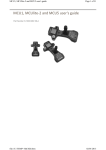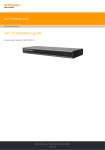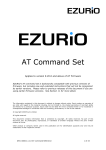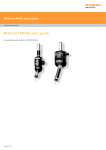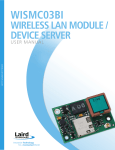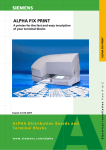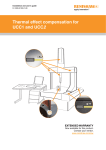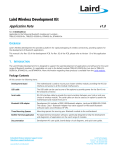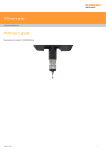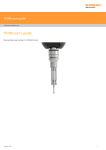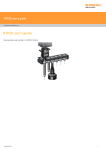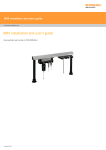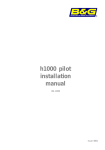Download MCU installation and user's guide
Transcript
MCU installation and user's guide http://www.renishaw.com MCU installation and user's guide Documentation part number H-1000-5182-03-A Issued 06 2013 1 of 41 MCU installation and user's guide http://www.renishaw.com General information © 2003 2013 Renishaw plc. All rights reserved. This document may not be copied or reproduced in whole or in part, or transferred to any other media or language, by any means, without the prior written permission of Renishaw. The publication of material within this document does not imply freedom from the patent rights of Renishaw plc. Disclaimer RENISHAW HAS MADE CONSIDERABLE EFFORTS TO ENSURE THE CONTENT OF THIS DOCUMENT IS CORRECT AT THE DATE OF PUBLICATION BUT MAKES NO WARRANTIES OR REPRESENTATIONS REGARDING THE CONTENT. RENISHAW EXCLUDES LIABILITY, HOWSOEVER ARISING, FOR ANY INACCURACIES IN THIS DOCUMENT. Trademarks RENISHAW® and the probe emblem used in the RENISHAW logo are registered trademarks of Renishaw plc in the UK and other countries. apply innovation is a trademark of Renishaw plc. All brand names and product names used in this document are trade names, service marks, trademarks, or registered trademarks of their respective owners. Windows XP, Windows 2000, Vista and Windows 7 are registered trade names of the Microsoft Corporation. All trademarks and trade names are acknowledged. Care of equipment Renishaw probes and associated systems are precision tools used for obtaining precise measurements and must therefore be treated with care. Changes to Renishaw products Renishaw reserves the right to improve, change or modify its hardware or software without incurring any obligations to make changes to Renishaw equipment previously sold. Warranty Renishaw plc warrants its equipment for a limited period (as set out in our Standard Terms and Conditions of Sale) provided that it is installed exactly as defined in associated Renishaw documentation. Prior consent must be obtained from Renishaw if non-Renishaw equipment (e.g. interfaces and/or cabling) is to be used or substituted. Failure to comply with this will invalidate the Renishaw warranty. Claims under warranty must be made from authorised service centres only, which may be advised by the supplier or distributor. Issued 06 2013 2 of 41 MCU installation and user's guide http://www.renishaw.com EC declarations of conformity Renishaw plc declare that the product: Name: MCUlite-2 and MCU5 Description: Manual control unit has been manufactured in conformity with the following standards: BS EN 61326-1:2006 BS EN 60204-1: 2006 Electrical equipment for measurement, control and laboratory use - EMC requirements Part 1: General requirements Immunity to Table 2 - industrial locations. Emissions to Class A - industrial locations. Safety of machinery - electrical equipment of machines Part 1 General requirements. and that it complies with the requirements of the following directives: 2004/108/EC Electromagnetic compatibility (EMC) 2006/95/EC Low voltage The above information is summarised from the full EC declaration of conformity. A copy is available from Renishaw on request. Renishaw plc declare that the product: Name: MCU W Description: Wireless manual control unit Part nos. A-5381-0019 Joystick unit A-5381-0020 Cradle unit A-5381-0004 Battery pack Complies with directive: 1999/5/EC Radio equipment and telecommunications terminal equipment and the mutual recognition of their conformity and complies with standards: Issued 06 2013 3 of 41 MCU installation and user's guide http://www.renishaw.com ETSI EN 300 328 V1.7.1 (2006-10) Electromagnetic compatibility and Radio Spectrum Matters (ERM); Wideband Transmission systems; Data transmission equipment operating in the 2,4 GHz ISM band and using spread spectrum modulation techniques ETSI EN 301 489-1 Electromagnetic compatibility and Radio Spectrum Matters (ERM); V1.8.1 (2008-04) Electromagnetic Compatibility (EMC) standard for radio equipment and services; Part 1: Common technical requirements ETSI EN 301 489- Electromagnetic compatibility and Radio Spectrum Matters (ERM); Electromagnetic Compatibility (EMC) standard 17 V2.1.1 (2009-05) for radio equipment; Part 17: Specific conditions for Broadband Data Transmission Systems BS EN 613261:2006 Electrical equipment for measurement, control and laboratory use – EMC requirements Part 1: General requirements Immunity to Table 2 - industrial locations. Emissions to Class A - industrial locations. BS EN 610101:2001 Safety requirements for electrical equipment for measurement, control and laboratory use. Part 1: General requirements. The above information is summarised from the full EC declaration of conformity. A copy is available from Renishaw on request. Issued 06 2013 4 of 41 MCU installation and user's guide http://www.renishaw.com FCC (USA only) Information to user (47CFR section 15.105) This equipment has been tested and found to comply with the limits for a Class A digital device, pursuant to Part 15 of the FCC rules. These limits are designed to provide reasonable protection against harmful interference when the equipment is operated in a commercial environment. This equipment generates, uses, and can radiate radio frequency energy and, if not installed and used in accordance with the instruction manual, may cause harmful interference to radio communications. Operation of this equipment in a residential area is likely to cause harmful interference, in which case you will be required to correct the interference at your own expense. Information to user (47CFR section 15.21) The user is cautioned that any changes or modifications not expressly approved by Renishaw plc or authorised representative could void the user's authority to operate the equipment. Equipment label (47CFR section 15.19) This device complies with part 15 of the FCC Rules. Operation is subject to the following two conditions: 1. This device may not cause harmful interference. 2. This device must accept any interference received, including interference that may cause undesired operation. Radio approval Europe: CE USA: FCC ID PI403B Canada: IC:1931B-BISMII India: ETA-172/2008 Korea: EL1-TRBLU23-00200 WEEE The use of this symbol on Renishaw products and/or accompanying documentation indicates that the product should not be mixed with the general household waste upon disposal. It is the responsibility of the end user to dispose of this product as a designated collection point for waste electrical and electronic equipment (WEEE) to enable reuse or recycling. Correct disposal of this product will help save valuable resources and prevent potential negative effects on the environment. For more information, please contact your local waste disposal service or Renishaw distributor. Issued 06 2013 5 of 41 MCU installation and user's guide http://www.renishaw.com Safety CAUTION: Before unpacking and installing the MCU W system, the user should carefully read the safety instructions below and ensure that they are followed at all times by all operators. Operators must be trained in the use and application of the MCU W system and accompanying products, in the context of the machine it is fitted to, before being allowed to operate that machine. Please ensure that you understand all safety instructions. Familiarisation with the MCU W system components is recommended. CMM should only be controlled from pre-determined zones or locations The communication cable between the UCC controller and the MCU / MCU W cradle should be routed so to avoid a trip hazard Do not put more than one MCU W into pairing mode at a time For safety reasons it is recommended that the joystick docking station is mounted outside the CMM working area Operation and maintenance If the equipment is used in a manner not specified by the manufacturer, any protection provided by the equipment may be impaired Do not position the MCU W cradle in such a position that it would be difficult to operate the E-STOP These products are only to be used with the appropriate Renishaw controller Installation of the MCU must be performed by trained personnel Do not edit any of the system files directly, only trained personnel may use the appropriate commissioning software package Remove the power before performing any maintenance operations Maintenance is restricted to procedures described in the maintenance section STOP buttons The MCU system offers three STOP buttons: Emergency STOP switch - RED STOP switch - YELLOW (located on MCU W joystick) Keypad STOP button (MCU5 and MCU W) MCU W battery A lithium-ion battery is used to power the MCU W joystick. It has been placed in an enclosure to provide protection against short circuits, overcharging and physical shock. Under no circumstances should attempts be made to open the battery enclosure, an unprotected battery is a hazard and can cause injury The battery contains hazardous chemicals and should be disposed of in accordance with local legislation or returned to Renishaw for correct disposal Only use the charger supplied Do not store in direct sunlight or damp conditions Do not heat or dispose of the battery in a fire Do not short circuit and avoid forced discharge of the battery If the battery becomes wet or physically damaged great care should be taken as it may become hot - if this occurs cease use immediately and dispose of the battery Issued 06 2013 6 of 41 MCU installation and user's guide http://www.renishaw.com If a battery starts to leak it should not be used and must be disposed of - care should be taken that any leaked fluids are not ingested or allowed to get into the eyes Do not subject the battery to violent shock, internal damage to the battery could occur which could cause it to overheat Do not attempt to charge the battery if the ambient temperature exceeds +40 °C (+104 °F) Please ensure that you comply with the international and national battery transport regulations when transporting batteries or MCU W. Lithium-ion batteries are classified as dangerous goods and strict controls apply on their shipment by air. To reduce the risk of shipment delays, should you need to return the MCU W to Renishaw for any reason, ensure the batteries are fitted to the MCU W and are not sent separately. Issued 06 2013 7 of 41 MCU installation and user's guide http://www.renishaw.com Warnings Beware of unexpected movement. The user should remain outside of the full working envelope of probe head and stylus. The machine supplier should ensure the user is aware of the full working envelope of the system. In all applications involving the use of machine tools or CMMs, eye protection is recommended. It is the machine supplier's responsibility to ensure that the user is made aware of any hazards involved in operation, including those mentioned in Renishaw product documentation, and to ensure that adequate guards and safety interlocks are provided. The product and the system components contain no user serviceable parts. No attempt should be made to disassemble any part of the product. In the event of a problem please contact your supplier for assistance. The cables must meet Renishaw specifications. Incorrect cabling could cause damage to the equipment. Under certain circumstances the probe signal may falsely indicate a probe-seated condition. Do not rely on probe signals to stop machine movement. Probe override will prevent machine backing off in the event of a probe collision. The MCUlite-2 / MCU5 / MCU W must be transported in Renishaw supplied packaging. This equipment is not suitable for use in a potentially explosive atmosphere. Issued 06 2013 8 of 41 MCU installation and user's guide http://www.renishaw.com Requirements Software requirements for installation The required version of UCCsuite: MCUlite-2 - UCCsuite 4.4 and greater MCU5 - UCCsuite 4.0 and greater MCU W - UCCsuite 4.4 and greater PSU specification requirements for MCU W operation Should a replacement PSU be required it is recommended that it be purchased from Renishaw, or it must meet the following specification: Output +24 Vdc, 0.6 A 2.5 mm dc jack connector (centre positive) To comply with electrical safety legislation the supply negative must be connected to the earth of the ac input and is single fault tolerant and approved to EN 60950-1 Issued 06 2013 9 of 41 MCU installation and user's guide http://www.renishaw.com Environmental conditions Indoor use IP40 (MCUlite-2 and MCU5) IP31 (MCU W) Altitude Up to 2000 m Operating temperature +5 °C to +40 °C Storage temperature 25 °C to +70 °C (MCUlite2 and MCU5) 20 °C to +60 °C (MCU W *) Relative humidity Relative humidity 80% maximum (noncondensing) for temperatures up to +31 °C. Linear decrease to 50% at +40 °C Pollution degree Pollution degree 2 as defined by BS EN 61010-1:2001 section 3.6.6.2. Normally only non-conductive pollution occurs. Occasionally, however, temporary conduction caused by condensation occurs. * Storing the MCU W battery at high temperatures is not recommended because it prematurely ages the battery. The maximum recommended times for storage of the MCU W battery are: 1 week at +60 °C 1 month at +45 °C 6 months at +40 °C 12 months at +35 °C Issued 06 2013 10 of 41 MCU installation and user's guide http://www.renishaw.com References and associated documents It is recommended that the following documentation be referred to when installing an MCU. Renishaw documents Title Document number Installation guide: UCC2 H-1000-5223 Installation guide: UCClite-2 H-1000-5109 Installation guide: UCC T3 H-1000-7578 Installation guide: SPA3 H-1000-7566 Installation guide: UCC T5 H-1000-7573 External documents National and international standards including the following may be applicable to the finished machine or installation: BS EN ISO 12100:2003 parts 1 and 2 Safety of Machinery - Basic Concepts, General Principles for Design. BS EN 60204-1:2006 Safety of machinery - Electrical equipment of machines - Part 1: General requirements. Issued 06 2013 11 of 41 MCU installation and user's guide http://www.renishaw.com Manual control systems description MCUlite-2 The MCUlite-2 is a basic entry level joystick . It has the controls necessary to control a 3-axis touch-trigger CMM but without the sophistication of an LCD display screen. NOTE: The MCUlite-2 is not compatible with UCC1. MCU5 The manual control unit is a comprehensive CMM joystick controller designed for use with Renishaw's universal CMM controller range. It includes the functionality of both the Renishaw standard UCC joystick interface and Renishaw PHC10 hand control unit (HCU1). The MCU5 is a derivative of the MCU1 joystick, the only difference being the addition of a STOP switch on the membrane keypad. The MCU5 has been developed for use with Renishaw's REVO system and PH20, where the STOP switch is provided to augment the ESTOP switch. The E-STOP switch has to cut the motor power to all the axes, including the two head axes. This is not always appropriate as the head A axis will drop to 0° by gravity. Operation of the STOP switch will bring the CMM to a fast stop but the motors will remain engaged in the ‘hold' state. NOTE: The MCU5 is not compatible with UCC1. MCU W The wireless manual control unit (MCU W) is a comprehensive joystick designed for use with Renishaw's range of UCC controllers. Based on the MCU5 joystick design, the MCU W uses modern battery technology and Bluetooth® radio modules to provide an effective wireless joystick with a maximum of twenty five metre range and over eight hours between battery changes. A spare battery and an automatic charger are included in the joystick docking cradle. NOTE: MCU-W is not compatible with UCC1. Issued 06 2013 12 of 41 MCU installation and user's guide http://www.renishaw.com MCUlite-2 features 1 Probe disabled LED (red) 9 Joystick 2 Emergency stop switch 10 Joystick locks (three separate buttons) 3 MCU status LED (tri-colour) 11 Servo engage 4 Speed override 12 Probe disable 5 Slow speed enable 13 Take point / cancel last point 6 Fast speed enable 14 F2 function 7 Slow speed enable 15 F1 function 8 Fast speed enable Issued 06 2013 13 of 41 MCU installation and user's guide http://www.renishaw.com MCU5 features 1 LCD screen 11 Start / stop program 2 Emergency stop switch 12 Mode change 3 Speed override 13 Joystick orientation 4 Probe disabled LED (red) 14 Axis system select (three colours) 5 MCU enabled LED (green) 15 F1 function 6 Joystick enable 16 F2 function 7 3-axis joystick with push button 17 Stop 8 Joystick locks (three separate buttons) 18 F3 function 9 Probe disable 19 F4 function 10 Servo engage (three colours) 20 Take point / cancel last point Issued 06 2013 14 of 41 MCU installation and user's guide http://www.renishaw.com MCU W features 1 LCD screen 12 Mode change 2 Stop switch 13 Joystick orientation 3 Speed override 14 Axis system select (three colours) 4 Probe disabled LED (red) 15 F1 function 5 MCU enabled LED (green) 16 F2 function 6 Joystick enable 17 Stop 7 3-axis joystick with push button 18 F3 function 8 Joystick locks (three separate buttons) 19 F4 function 9 Probe disable 20 Take point / cancel last point 10 Servo engage (three colours) 21 ON / OFF 11 Start / stop program Issued 06 2013 15 of 41 MCU installation and user's guide http://www.renishaw.com System operation Joystick enable button - MCU5 and MCU W On the MCU there is a single joystick enable button. The joystick enable button is intended to be used to prevent the accidental movement of the machine. Two actions are required to initiate CMM motion: press joystick enable button and operate the joystick. NOTE: On the MCUlite-2 the enable buttons are the green arrows in the green boxes. Joystick and associated button function All three axis movements are controlled from the one joystick. Moving the joystick left, right, backwards and forwards controls the CMM X and Y movements. The Z-axis is controlled by twisting the joystick clockwise and anti-clockwise (configurable) *. If a trigger event occurs during joystick operation, the CMM will stop and back away from the surface along the vector that it was travelling. After the back off operation, it is necessary for the joystick to return to its null position for a set period of time before the joystick will permit movement of the CMM. The default value is 0.05 seconds *. The back-off speeds and distances are defined by the UCC configuration settings *. When in head mode, operation of the joystick can move the axis of the head. Pushing the joystick forwards and backwards will operate the A-axis and twisting the joystick will operate the B-axis. When in rotary table mode, the W-axis of the table is controlled by the twisting of the joystick. * These values and configuration settings will have been set by your CMM service provider. Joystick axis locks buttons These permit the locking of one or more axes of the CMM, ignoring any joystick deflections for that axis. On each of the axis lock buttons there is an LED indicator that will light red when the respective axis is locked, on the MCU there will also be a padlock symbol next to the respective axis, see figure below. These buttons toggle on or off. NOTE: If an axis lock is released when the joystick is deflected, that axis is immediately free to move. NOTE: On the MCU the axis locks will be transposed when operation of the CMM joystick orientation function of the joystick is operated. Issued 06 2013 16 of 41 MCU installation and user's guide http://www.renishaw.com When the MCU is in head mode, the axis locks are applied to the comparable head axes. On the MCU, when the joystick is in head mode and a REVO head is fitted, the left / right axis lock button is used to initialise and cancel ‘SNAP ON'. ‘SNAP ON' is the ability to move the head to the nearest multiple of a defined head angle. These axis locks will only be active during manual (MCU) controlled CMM movements. When the CMM is under DCC operation, all axis locks will be released and re-latched when returning to manual operation. Probe disable button The probe disable button gives the CMM user the ability to move the CMM while the probe is triggered or disconnected by disabling the probe trigger signal. WARNING: When operating in this mode the probe is disabled and therefore probe contact with a surface will NOT stop the CMM. No measured data will be returned to the CMM host computer. The probe disable function will only work while in manual mode and cannot be applied while in DCC. Press and hold the joystick enable button and then press the probe disable button. The CMM can now be moved irrespective of the probe trigger status. Releasing the joystick enable button cancels the probe disable function. In all modes the application of probe disable is confirmed by the red probe disabled LED being illuminated. Engage button The engage button gives the CMM user the ability to engage or disengage the servos whilst the CMM is in manual mode. This button is configured as a toggle switch and has an associated LED to indicate the servo status. The LED (located within the button) identifies the various operational states and these are as listed below. On the MCU5 and MCU W, a symbol at the top of the LCD screen (shown below) also indicates whether the servos are engaged. Issued 06 2013 17 of 41 MCU installation and user's guide http://www.renishaw.com CMM servos are disengaged LED off – The CMM servos are disengaged CMM servos engaging LED amber – The servos are in the process of engaging CMM servos engaged LED red – The servos are engaged but the joystick is not enabled CMM servos engaged and movement is demanded LED green – The servos are engaged and the joystick is enabled and ready When REVO or PH20 are fitted, operating the engage switch to disengage the drives puts the REVO or PH20 into heavily damped mode where it will slowly droop due to gravity. The CMM axes will disengage as normal. Program button - MCU5 and MCU W This button can be used to request the application software to start or stop a DCC program by a system integrator. The button only gives an event to the application software and is not a state button. NOTE: It is the system integrator's responsibility to ensure adequate precautions are taken if this switch is utilised. If it is considered dangerous for the operator to be in the machine working volume when the DCC program is started, then a second confirmation switch operation is required (possibly one of the function switches) or this switch should not be enabled at all. If the button is used to start a program (enter auto mode), the LCD screen will display ‘AUTO', the speed, the controller status and an optional text line from the OEM whilst the program is running. If the button is used to stop a program (enter manual mode) the MCU5 / MCU W returns to the previous mode selected before going into DCC. The LCD screen will then display the normal features for that mode. Modes button- MCU5 and MCU W Issued 06 2013 18 of 41 MCU installation and user's guide http://www.renishaw.com There are six possible MCU5 / MCU W operational modes in addition to the DCC auto mode. Pressing the ‘MODE' button on the MCU keypad changes the MCU operational mode, the current mode is indicated in the top left of the LCD. NOTE: The modes available to the user of the MCU are configurable. If the mode is not required it can be switched off. CMM manual mode This mode is the default on start-up. In manual mode the LCD display will show the tip position of the stylus in the current part co-ordinate system, in either metric or imperial measurements. Head mode Head mode provides the user with control over the Renishaw PH10, PH20 or REVO heads. In this mode the joystick will move either of the motorised head axes. The LCD display will indicate the angle of the two head-rotation axes. For the PH10, the joystick fast / slow button will give jog operation if not pressed or fast sweep operation if pressed. For the REVO, the fast / slow button will control the speed. If no head is fitted then the LCD screen will display ‘None'. NOTE: To ensure correct operation, the head type must be set correctly within the configuration.ini file. With the REVO or PH20 head there is an additional facility of ‘SNAP ON'. The use of ‘SNAP ON' is controlled by the use of the left / right axis lock button. Repeated pressing will toggle the facility on and off. ‘SNAP ON' is displayed in text on the LCD display when it is selected. When ‘SNAP ON' is selected the up / down and twist operation of the joystick will move the REVO or PH20 ‘A' and ‘B' axes normally, but after about 1 second of the joystick being returned to its null position the head will automatically move to the nearest multiple of the snap angle. The snap angle is configurable via the configuration file. The maximum snap angle is 7.5° and the minimum is 0.05°. Rotary table mode This mode provides the user with control over a rotary table if it is connected to the system. Twisting the joystick will cause rotary table movement. The joystick fast / slow button will control fast (pressed) or slow (not pressed) operation. The LCD display will indicate its angle of rotation. Issued 06 2013 19 of 41 MCU installation and user's guide http://www.renishaw.com Sticky button mode The purpose of sticky button mode is to allow the user to alternate between two MCU modes without having to scroll through all of the enabled MCU modes. This feature could be useful when generating a part program using the application software teach utility, where alternating between CMM and head moves is often required. If the use of sticky button mode has been enabled by your CMM service provider, you will notice that when a MCU mode is selected, the title (e.g. CMM Manual, Head Mode, etc), will be highlighted by displaying it in reverse video (see following example). The highlighted mode title will persist for the time set in the sticky button time delay parameter. If you want to toggle between two specific modes, this can set by using the following procedure; a) Using the MCU mode switch, select one of the desired modes, then wait until the mode title returns to a normal video display. b) Next select the other desired mode and again wait for its mode title to return to normal video. c) The sticky buttons are now set. The next time you press the MCU mode button you will return to the original selected mode and, provided you do not press the MCU W mode button before the title has returned to normal video, the next button press will return you to the other selected mode, and so on. Sticky button mode is not permanent, you can still access the other modes. If the MCU W mode button is pressed before the previous mode title has returned to normal video, then the mode becomes unstuck and all the MCU W modes can be scrolled through. Joystick orientation button - MCU5 and MCU W The joystick orientation button changes the relative deflection of the joystick to be transposed to the actual axis of the CMM. This allows the user to move freely around any side of the CMM and transpose the joystick orientation such that the machine X and Y-axis correspond to joystick direction of deflection. If any axis lock is asserted and the joystick orientation is changed then the relative axis lock will be transposed also. Issued 06 2013 20 of 41 MCU installation and user's guide http://www.renishaw.com An arrow in the top right of the LCD indicates the orientation of the MCU, and pressing the joystick orientation button will enable the user to scroll through the four operational positions. The direction of the arrow is to indicate the +Y axis direction of the machine when the machine co-ordinate system is in force. NOTE: When switching the system to CMM auto mode, the joystick orientation feature will drop out and then be reasserted when the system is placed into CMM manual mode. Axis select button - MCU5 and MCU W The axis select button changes the CMM motion in any one of three different axis systems: Machine axis (green LED) In this axis system, the joystick directly controls the machine axes, i.e. a forward deflection of the joystick produces a pure Y+ movement of the CMM. This is the default machine setting when the machine is initialised. Part axis (red LED) In this axis system, the joystick controls the machine axes in the current part axis system. i.e. a forward deflection of the joystick produces a movement in the part Y+ direction. This could be a compound of two or three machine axes. Stylus axis (amber LED) In this axis system, the joystick controls the machine axes in the axis system of the selected stylus. i.e. a twist (Z) deflection of the joystick produces a movement along the axis of the probe stylus. This could be a compound of two or three machine axes. The stylus axis is a secondary part coordinate system, applicable only to the MCU joystick, and this needs to be updated by the application software to reflect the active stylus axis. The axis system in which the MCU is moving the CMM is indicated on the LCD by indicating the axis system that is active by a M, P or S, and by a tri-colour LED mounted below the axis select button. Pressing the axis select button will enable the user to scroll through the 3axis systems. To change to the required axis system the axis select button must be pressed and held on the desired axis system. This selection is confirmed by pressing the joystick enable switch. Both switches can then be released. This complex change procedure prevents unintentional changing of the axis system which could give unexpected machine movement. Issued 06 2013 21 of 41 MCU installation and user's guide http://www.renishaw.com Take point / cancel point This button is designed to allow the user to record or cancel chosen machine positions. When a program is being generated by the teach and learn method, the user will use the take point button to permit the CMM to record a waypoint and use it in the program. When using the cancel point button it will indicate to the application software that the point just taken (either a touch point or a position generated by the take point button) should be removed from the program. The cancelling process can be repeated many times and the front-end program will use it to delete multiple stored points. NOTE: When the take point button is pressed, the machine's XYZ position will be recorded and a waypoint is created. However, if the MCU is in rotary head mode or table mode, it only records the relevant index position. Function buttons The application software can define the function buttons. Their status can be read at any time and in any mode. These buttons have no effect on the UCC controller as they are solely for the use of the front-end software. The associated keypad LEDs can also be switched on and off at any time. An example of use is that one of the buttons may be used to initiate a circle measurement command when the system is in a manual mode and being used for teach and learn programming. Keypad STOP button - MCU5 and MCU W The STOP button only operates when the CMM is in automatic (DCC) mode. It gives the operator the ability to rapidly stop the CMM, REVO head and PH20 without disengaging. When the CMM has stopped the system stays in hold state with both the CMM and REVO head engaged. Issued 06 2013 22 of 41 MCU installation and user's guide http://www.renishaw.com STOP button - MCU W Yellow STOP button mounted on the MCU W joystick. When this button is pressed all CMM and motorised head motion is halted. LCD - MCU5 and MCU W This LCD screen is context sensitive to the mode and operation of the MCU. Please refer to the relevant operational mode section for further details. Emergency STOP switch A red emergency STOP switch is mounted on the MCUlite-2 and MCU5 and on the MCU W cradle which is hard wired to the UCC controller. It complies with EN13850 and when connected to a UCC / SPA the system can comply as either a category 2 or category B ESTOP system as defined in EN954-1:1996 (ISO13849-1:1999). When this switch is operated power to all the CMM axes is removed. Speed override - MCUlite-2 and MCU5 Controls the machine speed when the CMM is running a program under DCC mode. It will also control the speed of the REVO head and PH20 if fitted. The LCD screen displays a percentage value of the programmed move speed when in DCC operation as shown below. If the speed override is set to less than 10%, the speed percentage shown on the LCD display will flash. Speed override - MCU W If the joystick is taken out of range while the CMM is moving in automatic mode the loss of the radio link will not stop the CMM, but if the speed control is changed while the joystick is out of range the following actions are required when the joystick is reconnected. If the new demanded speed is lower than the value set before the link was lost then the CMM will immediately slow down to the new speed when the joystick link is reconnected. If the new demanded speed is higher than the value set before the link was lost then, when the joystick link is reconnected, the CMM will keep on moving at the old speed but the display of % speed will be reversed (white on black as shown below). The speed will be frozen until the speed control is turned down through the old speed value. The speed control will then again be functional. Issued 06 2013 23 of 41 MCU installation and user's guide http://www.renishaw.com Probe disabled LED The probe disabled LED Indicates the status of the touch probe signal. If the LED if OFF, the probe is in normal operational mode. If the LED is ON (red), the probe is disabled. MCU enabled LED The MCU enabled LED Indicates the operational status of the MCU. This LED has two states. If the LED is OFF, the MCU not enabled. If the LED is ON (green), the MCU is enabled. NOTE: The MCU enabled LED is not illuminated until the joystick is live. If the setting is selected that means the joystick enable button has to be operated, the LED will not illuminate until this is done. If both the MCU enabled LED is flashing red and green and the probe disabled LED is flashing red, this indicates there is a scale failure on one of the CMM axes. Specific MCU W screen displays Wireless communication Wireless communication is activated Manual operation, wireless communication - ON, battery - fully charged Joystick pairing Pairing lost, (out of range or loss of power to cradle) waiting for the connection Pairing failed Joystick docking MCU W joystick is docked in the cradle Manual operation, MCU W joystick docked, battery fully charged Issued 06 2013 24 of 41 MCU installation and user's guide http://www.renishaw.com The lock The key in the MCU W cradle is in the locked position, the MCU W joystick is deactivated and any manipulation of it will not result in the CMM movement Manual operation, MCU W joystick locked / disabled, battery fully charged Out of range The link has been lost due to the MCU W joystick being out of range or the power supply to the MCU W cradle failing Manual operation, MCU W joystick out of range, battery fully charged Batterystatus Battery full Battery half full Battery empty Battery fault / missing Power-saving screen back light After 60 seconds the back light behind the screen turns off if the joystick has not been used To activate the screen back light press the joystick enable button Issued 06 2013 25 of 41 MCU installation and user's guide http://www.renishaw.com Installation Part numbers There are three MCU joysticks available: A-5121-0003 - MCU5 kit A-5331-0015 - MCUlite-2 kit A-5121-0077 - MCU W kit (does not include batteries *) * NOTE: The MCU W kit does not include a battery. When placing an order, please remember to include the MCU W battery kit (Renishaw part number: A-5121-0079). Each of these kits are provided with a 5 metre flexible joystick cable. Replacement or longer cables are available from your machine supplier or directly from Renishaw. A-1016-8098 - 5 m cable A-1016-8099 - 10 m cable A-1016-8100 - 20 m cable Connecting the MCU to the UCC controller The MCU joystick kits include a 5 metre flexible cable provided as standard. The cable is fitted from 9 pin D connector on the rear of MCU to a 9 pin D connector on the rear of the UCC controller. Connecting to the UCC2 Issued 06 2013 26 of 41 MCU installation and user's guide http://www.renishaw.com Connecting to the UCClite-2 Connecting to the UCC T3 The emergency stop button on the MCUlite-2, MCU5 or MCU W has a dedicated circuit that is fed directly into the rear of the UCC controller. These connectors are then integrated to the CMM's emergency stop system in the Renishaw servo power amplifiers or UCC controller. If non-Renishaw servo power amplifiers are used then it is the integrators responsibility to connect the MCU E-STOP switch into the emergency stop system. Issued 06 2013 27 of 41 MCU installation and user's guide http://www.renishaw.com MCU W cradle - switching on and off The MCU W cradle key is designed to control the use of the MCU W joystick, i.e. to activate or deactivate it when needed. MCU W joystick activation To activate the joystick the operator has to insert the key as shown in the picture and turn it from the position OFF to ON. These positons are indicated on the MCU W cradle. MCU W locking position ON MCU W locking position OFF MCU W joystick deactivation The operator can disable the joystick by switching the key to off and removing the key from the cradle - this prevents the CMM machine from unauthorised use The key is only removable when it is in the OFF position, which is confirmed by a key symbol displayed on the MCU W screen Issued 06 2013 28 of 41 MCU installation and user's guide http://www.renishaw.com Pairing the MCU W joystick with the cradle The MCU W is a wireless joystick that communicates with the CMM through the hard-wired MCU W cradle. The communication between the joystick and the cradle is through a Bluetooth® wireless communication link and operates up to 25 meters lineofsight between the MCU W joystick and the cradle. The MCU W is supplied pre-paired and this procedure is only required if part of the system is replaced. This proceedure is only required if part of the system has been replaced. Prior to pairing the MCU W cradle to the joystick please ensure that: The MCU W cradle power cable is unplugged The MCU W joystick is switched off To pair the MCU W joystick to the cradle please do the following: 1. Press the ON / OFF button on the MCU W. 2. While the LEDs are flashing, press and hold the PROG button until the LEDs stop flashing. 3. Plug in the MCU W cradle power cable and wait for the MCU W cradle LEDs to stop flashing. Issued 06 2013 29 of 41 MCU installation and user's guide http://www.renishaw.com 4. Press and hold the recessed switch at the back of the MCU W cradle until the blue pairing status LED starts to flash rapidly, this should be about five times a second. The MCU W screen will show the pairing process has started which takes approximately 30 seconds. Both the cradle and joystick will search for 60 seconds before timing out. The status of the pairing Successful pairing is indicated by message timer symbol on the screen indicating that the joystick is ready for use and waiting for communication from the UCC controller. The pairing status LED on the MCU W cradle is solid blue. A red pairing status LED indicates that no pairing exists. Issued 06 2013 30 of 41 MCU installation and user's guide http://www.renishaw.com The operation range of the MCU W Bluetooth® communication The wireless communication link operates up to a range of 25 metres line-of-sight between the MCU W joystick and the cradle. Non lineof-sight range is dependent on the number and type of obstructions. Issued 06 2013 31 of 41 MCU installation and user's guide http://www.renishaw.com The use of the MCU W ID labels MCU W labels should be used to identify the joystick with its paired MCU W cradle, they are intended to avoid confusion if multiple MCU W systems are operating in the same area. Ensure that the ID labels are stuck to both the MCU W joystick and cradle. Ensure that the ID labels are updated if a MCU W joystick is paired with a new cradle. Issued 06 2013 32 of 41 MCU installation and user's guide http://www.renishaw.com MCU W cradle LED indicators There are 3 LEDs on the MCU W cradle. The specification for the MCU W LEDs is as follows: Power LED LED status Interpretation Not lit No power Amber Power, but the key-switch is in the OFF position, meaning the joystick is locked Green Power, and the key-switch is in the ON position, meaning the joystick is unlocked Spare battery status LED LED status Interpretation Not lit No battery Amber Battery charging Green Battery fully charged Slow flashing red Battery fault Pairing status LED LED status Interpretation Red Cradle has not been paired with a joystick Slow* flashing blue Partner joystick is out of range or not switched on Fast* flashing blue Pairing with joystick Blue Normal operation (connected to joystick) Any other combinations of colours or flashing patterns are classified as an error. NOTE: * A slow flash is twice per second, fast is five times per second. Issued 06 2013 33 of 41 MCU installation and user's guide http://www.renishaw.com MCU W battery operation and maintenance The MCU W kit contains two batteries. One battery should be placed in the joysick, whereas the spare one should be kept in the cradle where it is continously recharged when the cradle is powered and switched on. MCU W first usage Before using the MCU W for the first time please check the batteries for damage or leakage. If either is found do not use. When the batteries are shipped they are usually 30% charged and can be used immediately. The battery status is confirmed by: the charge power status LED the screen display When the battery status is low, which is indicated by the charge power status LED or the screen display, please replace it with the spare battery from the cradle. Maintenance A new battery powers the MCU W for at least 8 hours under normal usage conditions. Elevated temperatures will reduce battery life. It might not be necessary to exchange with the battery in the cradle, as the joystick battery will be charged each time the joystick is replaced in the cradle. The batteries supplied with MCU W should be swapped at least once a month. Safety related to the MCU W battery usage Please refer to the appropriate section of the MCU W safety information. Issued 06 2013 34 of 41 MCU installation and user's guide http://www.renishaw.com MCU W ON / OFF switch Turn unit on and off by pressing and holding down the button for three seconds The MCU W joystick powers down automatically into a safe state when the voltage of the battery becomes low Issued 06 2013 35 of 41 MCU installation and user's guide http://www.renishaw.com Joystick configuration There are various configuration settings that have to made to ensure the MCU joystick functions to the operator's requirements. These settings must be made when setting up the UCC controller using the UCCassist-2 commissioning software. They are described in the following table: Parameter Default value Comment JoystickMaxFastSpeed 100 mm/s This value is the target speed for full joystick deflection with the joystick fast button operated. JoystickMaxFastAcceleration 500 mm/s² This is the maximum acceleration and deceleration value used when operating the joystick in fast mode. JoystickMaxTouchSpeed This value is the target speed for full joystick deflection in measure mode (without the joystick fast button operated). 30 mm/s JoystickMaxTouchAcceleration 30 mm/s² This is the maximum acceleration and deceleration value used when operating the joystick in measure mode. StandardBeepTime 0.2 s This controls the time the MCU buzzer operates for a probe trigger event, it can be set to zero if the buzzer is not required. ZAxisDirection N/A The standard configuration is for a clockwise rotation of the joystick to cause –Z motion. This can be inverted if required. InitialMCUOrientation N/A This parameter sets the initial orientation of the MCU, the default setting is that forward movement of the joystick will cause +Y motion of a YXZ configured machine. EnableButtonDelay N/A This setting enables the use of the “Joystick Enable” button, the default setting is enabled, if its use is not enabled then the joystick will always be live when the machine is in manual mode (not recommended). EnableButtonOperation N/A If the use of the “Joystick Enable” button is enabled this parameter sets the time after the button has been operated that the joystick is enabled for. The default setting is 0, i.e. the button has to be depressed to allow motion. NumberOfMCUModes 5 This setting controls the number of MCU modes that can be accessed. ModesSequence N/A These settings control the mode types and the sequence in which they are displayed. NullWaitTime 0.05 s If a limit switch or surface is encountered when under joystick control the system will switch to automatic mode for the backoff, the null wait time sets the time the joystick has to be in its null position after the backoff has finished before joystick movement is permitted. EnableJoystickSpeedOverride N/A The speed override control is normally enabled when the machine is in DCC mode, this can be disabled using this control. RemeasureMode N/A This parameter switches on and off remeasure mode. The default setting is off. StickyButtonTimeDelay 0s This parameter sets the sticky button time delay (see section 2.12.6) The default setting is 0 (off). NOTE: The joystick assembly has deadbands. In joystick mode the first 11% of mechanical movement does not produce motion and full speed is reached at 91%. These deadbands are necessary to accomodate electro-mechanical tolerences in the joystick assembly. These settings are not user configurable. Issued 06 2013 36 of 41 MCU installation and user's guide http://www.renishaw.com Maintenance MCUlite-2, MCU5 and MCU W have no user serviceable parts. There is an E-STOP repair leaflet (Renishaw part number H-1000-7601) available for these joysticks. Should a unit become defective for any other reason then it should be returned to the nearest Renishaw service centre. The MCU may be kept clean by wiping with a clean, damp lint-free cloth. Do not use solvents. Replacement connection cables can be purchased through the CMM provider or direct from Renishaw: CAUTION: Always follow to the safety instructions given in this guide. Failure to do so could adversely affect the performance of the MCU system and / or lead to personal injury. NOTE: The external surfaces of all system components can be cleaned with a water damped cloth but all parts should be kept dry. Keep MCU contacts clean and free from dirt using non-abrasive material. Issued 06 2013 38 of 41 MCU installation and user's guide http://www.renishaw.com Fault finding Examining the MCU LCD display, status LEDs, the system configuration and current conditions, can solve many problems. NOTE: As with most cable connected ancillary equipment, it is the actual cable that is the most vulnerable part, particularly with a joystick where it can be trapped by the part under inspection, pulled if caught by machine motion, trodden on, run over, etc. If any malfunction with the MCU occurs, the first step should be an examination of the cable. Suspect operation of joystick or buttons There is a comprehensive test program for the MCU joystick operation and button function within UCCassist-2. Plese refer to the UCCassist-2 user's guide (Renishaw part number H-1000-5224) for details. The joystick will not move the CMM Several conditions have to be satisfied before joystick controlled moves can be made: That is connected to the UCC and has been set up in the configuration file The joystick should be 'enabled' The MCU ‘joystick enable' button must be pushed The axis locks must not be applied The CMM application software must be in manual (joystick) mode The probe must not be ‘deflected', unless probe override is on No limit switches should be open, unless disabled The CMM position must be inside all ‘soft limits' if these are enabled The speeds are too low or too high Check the joystick speeds and accelerations that are set in the UCC configuration file, are correct. Check the operation of the fast/slow switch. Higher speeds will be obtained when this switch is active The motors disengage during joystick operation If the joystick max speed is set to a high value, the machine may be able to exceed the maximum move speed to cause an overspeed error. If the joystick max fast acceleration is set to too high a value, the motor signals may attempt to exceed the overdrive limits and cause an overdrive fault If the system proportional gains are set too high, or the velocity gains are too low, an overdrive fault may occur Speed override does not work correctly This feature must be enabled separately from the general joystick enabling: it is an entry in the UCC configuration file NOTE: Speed override ONLY works on DCC moves and scanning. It is not operational when the MCU is in manual (joystick) mode. Issued 06 2013 39 of 41 MCU installation and user's guide http://www.renishaw.com Servos will not engage E-STOP not connected correctly E-STOP still asserted An outer limit switch is activated No screen display Check cable connection Issued 06 2013 40 of 41 Renishaw plc New Mills, Wotton-under-Edge, Gloucestershire, GL12 8JR United Kingdom T +44 (0)1453 524524 F +44 (0)1453 524901 www.renishaw.com/cmmsupport For worldwide contact details, please visit our main website at www.renishaw.com/contact Issued 06 2013








































